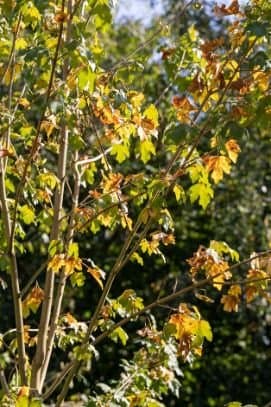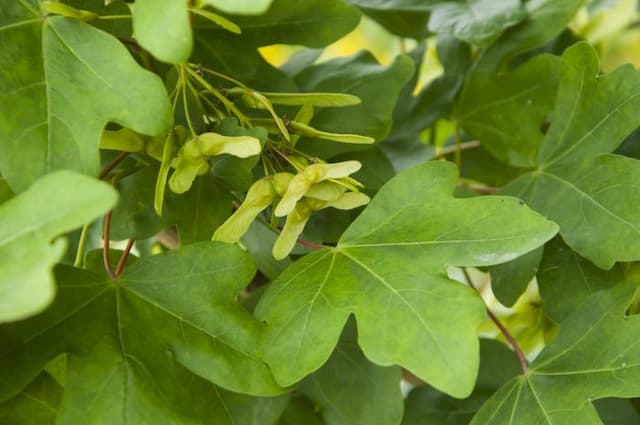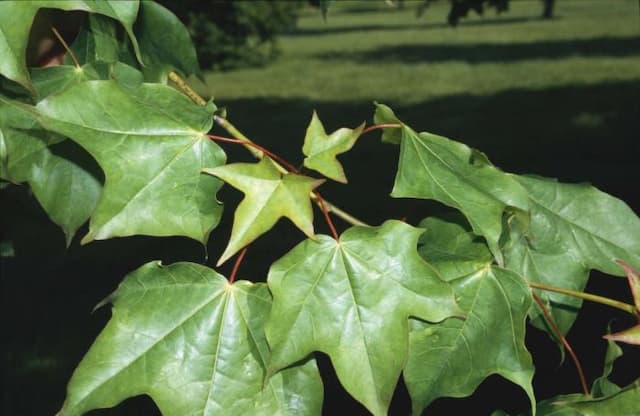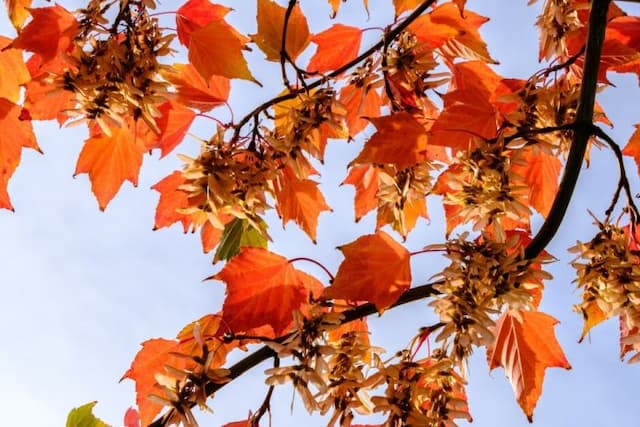Variegated Sycamore Acer pseudoplatanus f. variegatum 'Simon-louis Frères' (v)

ABOUT
The Acer pseudoplatanus f. variegatum 'Simon-louis Frères', commonly known as Sycamore Maple, is characterized by its striking foliage. The leaves are large and palmate, meaning they are shaped like an open hand with five to seven deep lobes spreading outward. What sets this variety apart is its variegated leaves, which display a beautiful mixture of colors. The base color of the leaves is a lush green, and they are splashed with cream or white streaks and spots that can cover a significant portion of the leaf surface, creating a striking contrast against the green backdrop. This variegation can give the entire plant a lighter appearance, especially when viewed from a distance. In addition to the foliage, the Sycamore Maple may produce small, inconspicuous flowers followed by winged seeds, which are a typical feature of maples. Its overall appearance is elegant, with a spreading canopy of leaves that create dappled shade beneath. The bark of the tree is also noteworthy, with a pattern that can add visual interest to the landscape even during the leafless months of winter.
About this plant
 Names
NamesSynonyms
Variegated Sycamore Maple, Simon Louis Frères Maple.
Common names
Acer pseudoplatanus 'Simon Louis Freres', Acer pseudoplatanus var. Simon Louis Freres.
 Toxicity
ToxicityTo humans
The common name of Acer pseudoplatanus f. variegatum 'Simon-louis Frères' (v) is the Variegated Sycamore Maple. Generally, Sycamore Maples are not considered toxic to humans. However, contact with the sap has been reported in some cases to cause skin irritation or allergic reactions in sensitive individuals. Ingesting parts of this plant typically does not result in serious poisoning. If sap contact does cause skin irritation, symptoms may include redness, swelling, and itching. Ingesting large quantities of leaves or seeds is not advisable, but it rarely leads to severe symptoms. It is always recommended to exercise caution and prevent children from ingesting plant material.
To pets
The Variegated Sycamore Maple, scientifically known as Acer pseudoplatanus f. variegatum 'Simon-louis Frères' (v), is not commonly listed as a toxic plant to pets. This includes both cats and dogs. However, there is some evidence that the leaves, particularly when wilted or in large quantities, can cause horse atypical myopathy, a serious condition in horses that can be caused by the ingestion of hypoglycin A found in sycamore maple seeds and possibly leaves. This condition leads to muscle damage and can be fatal in horses. The seeds may also pose a choking hazard for smaller pets. While toxicity to common pets like cats and dogs is minimal, it is still recommended to prevent pets from ingesting parts of the tree as a general safety precaution.
 Characteristics
CharacteristicsLife cycle
Perennials
Foliage type
Deciduous
Color of leaves
Mixed
Height
35 feet [10.7 meters]
Spread
30 feet [9.1 meters]
Plant type
Tree
Hardiness zones
5
Native area
Europe
Benefits
 General Benefits
General Benefits- Ornamental Value: The distinctive variegated foliage of Acer pseudoplatanus 'Simon-Louis Frères' offers aesthetic appeal to gardens and landscapes.
- Shade Provision: As a sizeable tree, it can provide ample shade, making it suitable for parks and large gardens.
- Habitat for Wildlife: Provides a habitat and food source for various bird species and insects.
- Seasonal Interest: Its leaves change color with the seasons, which adds year-round interest to its surroundings.
- Durable Wood: The timber from this sycamore is hard and durable, suitable for furniture making and other woodcrafts.
- Erosion Control: Its extensive root system can help to prevent soil erosion, particularly on slopes or in areas with loose soil.
 Medical Properties
Medical PropertiesThis plant is not used for medical purposes.
 Air-purifying Qualities
Air-purifying QualitiesThis plant is not specifically known for air purifying qualities.
 Other Uses
Other Uses- The Sycamore maple's variegated leaves can be pressed and used in craft projects or to create natural art pieces.
- Wood from the Sycamore maple can be used in woodworking to create ornamental objects such as bowls, due to its attractive grain and workability.
- The strong and long-lasting wood is suitable for making musical instruments like violins and guitars that require a hard, dense timber.
- Sycamore maple sap can be tapped and reduced to make a syrup similar to maple syrup, although it is less common and has a different flavor profile.
- Its wood shavings and sawdust can be used as mulch or composted to enrich garden soils.
- The large leaves can be used as natural wraps for outdoor cooking, imparting flavor to steamed or grilled foods.
- The tree can be grown and pruned to create living structures or furniture, such as arbors or chairs, as part of a garden design.
- Seasoned Sycamore maple wood is suitable for smoking meat and fish, as it imparts a mild, sweet flavor.
- The tree can serve as a host for cultivating certain types of edible mushrooms that prefer hardwood, such as Shiitake.
- The tree's patterned bark can be used as a natural stencil for painting and creating textures in artwork.
Interesting Facts
 Feng Shui
Feng ShuiThe Sycamore Maple is not used in Feng Shui practice.
 Zodiac Sign Compitability
Zodiac Sign CompitabilityThe Sycamore Maple is not used in astrology practice.
 Plant Symbolism
Plant Symbolism- Strength: The Great Maple tree, to which Acer pseudoplatanus f. variegatum 'Simon-Louis Frères' belongs, traditionally represents strength due to its robust wood and enduring nature.
- Longevity: Maples are known for their long lifespan, symbolizing endurance and the passage of time.
- Independence: Each maple tree has a unique pattern on its leaves, especially the variegated forms like 'Simon-Louis Frères', symbolizing individuality and independence.
- Peace: The calming presence of the maple tree is often seen as a symbol of peace and tranquility.
- Welcoming: In some cultures, the maple tree is considered a hospitable and welcoming plant, possibly due to its broad canopy offering shade and protection.
- Balance: The 'Simon-Louis Frères' variegation can represent the balance between different aspects of life, reflecting the harmony between the natural world and human influence.
 Water
WaterThe Variegated Sycamore Maple should be watered deeply once a week, allowing the soil to become slightly dry between watering. Use a soaker hose or drip system to apply water directly to the soil, minimizing moisture on the leaves to prevent fungal diseases. In the absence of rainfall, provide about 1.5-2 gallons of water for young trees, increasing the amount as the tree matures and the root system grows. During hot and dry spells, you may need to water twice a week, while during cooler and wetter periods, reduce the frequency of watering accordingly.
 Light
LightThe Variegated Sycamore Maple thrives best in full sun to partial shade. Ideally, it should receive at least 4 to 6 hours of direct sunlight daily, but it can also tolerate light dappled shade. Avoid placing it in deep shade, as this can reduce the vibrancy of the variegated leaves and limit growth.
 Temperature
TemperatureThe Variegated Sycamore Maple is hardy and can withstand temperatures from as low as -20°F to as high as 100°F. The ideal temperature for optimal growth is between 60°F and 70°F. This maple will do well in typical outdoor conditions in most regions that experience temperate climates.
 Pruning
PruningPrune the Variegated Sycamore Maple in late winter or early spring before new growth begins to remove any dead, damaged, or diseased wood, and to shape the tree. Light pruning can be done throughout the year, but major structural pruning should be done during the dormant season when the tree's energy is conserved. Thinning the canopy every few years allows for better air circulation and light penetration.
 Cleaning
CleaningAs needed
 Soil
SoilThe Sycamore Maple 'Simon-Louis Frères' prefers a well-draining soil rich in organic matter; a mix of loamy soil, compost, and coarse sand works well. The ideal pH for this variegated cultivar should be mildly acidic to neutral, ranging from 5.5 to 7.5.
 Repotting
RepottingThe Sycamore Maple 'Simon-Louis Frères' typically needs repotting every 2-3 years to ensure continued growth and to refresh the soil. Younger, more vigorous trees may require more frequent repotting.
 Humidity & Misting
Humidity & MistingThe Sycamore Maple 'Simon-Louis Frères' thrives in moderate humidity levels typical of outdoor environments but can adapt to lower humidity levels if grown indoors.
 Suitable locations
Suitable locationsIndoor
Place in bright, indirect light, ensure proper drainage.
Outdoor
Full sun to partial shade; shelter from strong winds.
Hardiness zone
4-7 USDA
 Life cycle
Life cycleAcer pseudoplatanus f. variegatum 'Simon-Louis Frères', commonly known as the Variegated Sycamore Maple, begins its life cycle with seed germination, typically after a period of cold stratification which mimics winter conditions. The seedling emerges in spring, establishing a root system and a shoot that will develop into a trunk. As the tree grows, it undergoes a juvenile phase where it develops leaves which are variegated in this particular cultivar, showing patches or patterns of different colors, and it will not yet be reproductive. After a few years, it reaches maturity and can produce flowers, which are typically small and green, inconspicuous, appearing in early spring before the leaves. Pollinated flowers will develop into winged fruits called samaras, which disperse by wind, allowing the cycle of germination to occur anew if conditions are suitable. Throughout its life, the Variegated Sycamore Maple will continue to grow and can reach considerable heights, living for many decades, possibly over a century, before eventually succumbing to age, disease, or environmental factors.
 Propogation
PropogationPropogation time
Spring to Summer
The most popular method of propagating Acer pseudoplatanus f. variegatum 'Simon-Louis Frères', commonly known as the variegated sycamore maple, is by seed. Planting should commence in fall after the winged seeds, known as samaras, have matured. Typically, seeds are collected from the tree once they have dried and the wings have loosened. The seeds are then sown in a cold frame or outdoors in a prepared seedbed. It’s important to sow them at a shallow depth, covering lightly with soil. They need a period of cold stratification, which occurs naturally when sown outdoors in the winter. Seeds will usually germinate in the spring as temperatures rise.









